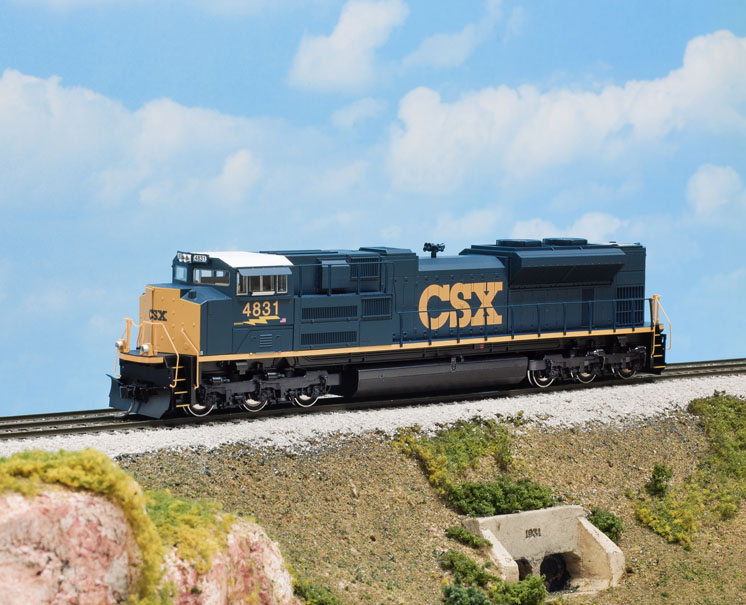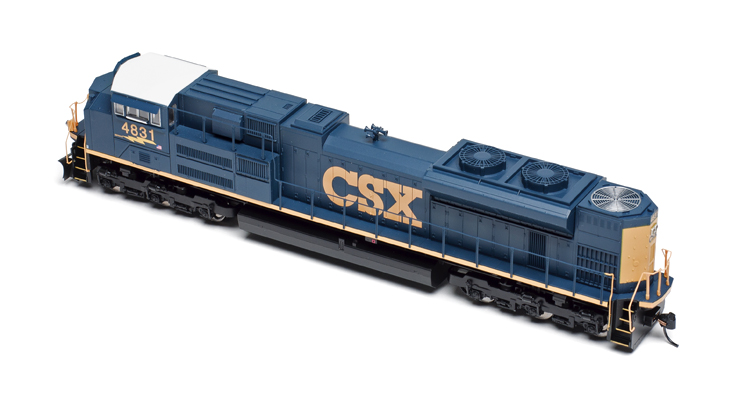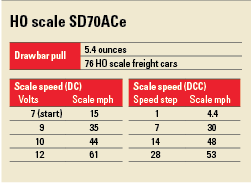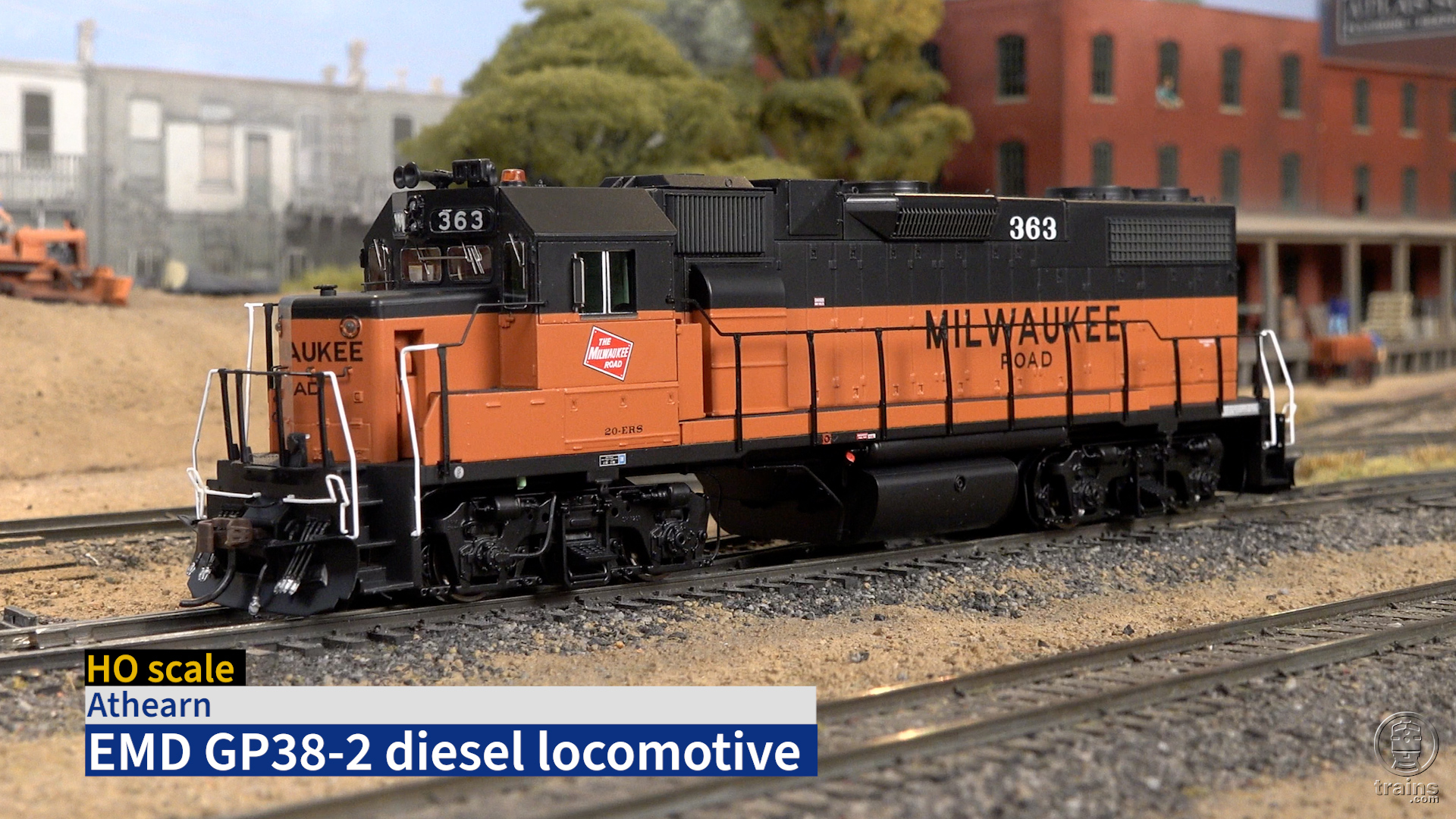Wm. K. Walthers has a treat for fans of modern motive power: an attractively priced HO scale Electro-Motive Diesel SD70ACe, ready to detail and weather. Part of the WalthersMainline series, this brawny model is available with or without SoundTraxx Digital Command Control and sound.
Emissions accomplished. Both EMD, then still part of General Motors’ Electro-Motive Division, and General Electric unveiled new locomotive models in 2004 to meet Tier 2 emission standards as specified by the United States Environmental Protection Agency. General Electric’s new locomotive was the GEVO ES44AC; EMD’s new locomotive was the SD70ACe, based on its established SD70 platform, but with a new prime mover. The AC part of the name refers to the diesel-electric locomotive’s alternating-current traction motors; the “e” stands for “eco.”
Almost 1,900 SD70ACes were produced until January 2015, when the EPA’s Tier 4 emission standards kicked in. Though it continued to be produced for a short time in Mexico for use only in that country, the SD70ACe was replaced in late 2015 by the SD70ACe-T4.
First impressions. The model’s major dimensions checked out against SD70ACe drawings published in our November 2004 issue, with the exception of the overall length over the couplers’ pulling faces. Model couplers are typically longer than prototypical to allow for operation on tighter curves.
The paint on our model was smooth and evenly applied, though the blue on our sample looked darker and less saturated than that seen in many of the prototype photos I found online. The model’s simplified paint scheme doesn’t include the numerous warning stencils and stickers seen in prototype photos.
The yellow printing was even and opaque, though there were voids where the large CSX logo crossed door panel lines on the hood. I noticed that on the prototype, the lightning bolt under the cab number is a brighter shade of yellow than the lettering – a feature correctly reproduced on the model.
In 2008, EMD started equipping its SD70ACes with isolated cabs in response to BNSF’s complaints about noise and vibration in the cab. Our sample model has the nose gasket groove characteristic of an isolated cab, though CSX no. 4831 was built in 2004 and doesn’t have an isolated cab. There is a grill at the top rear of the inverter box that’s also characteristic of a later phase SD70ACe, built after 2008. This shell is correct for most of the offerings in Walthers’ run.
The engine’s cast-metal frame surrounds the motor, flywheels, and drivetrain. Another hefty weight fills the fuel tank. The speaker on our DCC-equipped sample points downward above the rear truck. The nearly 11⁄2-pound locomotive has an impressive 5.4 ounce drawbar pull, which is equivalent to a free-rolling, 76-car train on straight and level track.
The blackened-metal RP-25-contour wheels on our test sample were all in gauge. Both Proto-Max metal couplers were mounted slightly low. A replacement set of Kadee underset-shank couplers should take care of that.
On the test track. I first tested the locomotive under direct current, using a Model Rectifier Corp. Tech4 power pack. When the throttle reached 6V, the locomotive’s sound chip began to cycle, starting and resetting repeatedly. This is a common issue with dual-mode sound decoders, caused when the current draw of the speaker kicking in drops the voltage below the decoder’s requirements. Turning up the voltage to 8V made the engine respond steadily, upon which it took off down the track at 27 scale mph. I could then lower the throttle to 7V, which resulted in a 15 scale mph speed.
Having encountered this issue before, I knew how to fix it: Configuration Variable 63. Using our NCE Power Cab DCC controller, I programmed CV63 – Analog Start Voltage – to a value of 50. This increased the voltage supplied to the motor on startup, allowing it to stay on at a lower throttle setting. After making this change, diesel engine sounds came on steadily at 6V, and the engine rolled along at 1.5 scale mph at 7V. (The speeds listed in the table are out-of-the-box.)
Under DC control, the diesel engine sounds ramped up and down realistically as I adjusted the speed. When starting at slow speed, the horn sounded automatically – two short toots forward, three when starting in reverse. The bell sounded continuously when moving below about 10 scale mph.
Under Digital Command Control, the engine started moving in speed step 1 at 4.4 scale mph. Switching my throttle to 128 speed steps resulted in a more stately 1.5 scale mph slow roll in speed step 1. The locomotive reached a top speed of 53 scale mph in speed step 28, lower than the prototype’s rated top speed of 70 mph, but realistic for a loaded train.
Running the locomotive under DCC also gave me more control of the sound and lighting effects. F1 sounded the bell; F2 played a long blast of the horn, F3 a short one. F5 turned on the ditch lights.
Wanting to make the ditch light operation more realistic, I consulted a SoundTraxx Tsunami manual online. The decoder used in WalthersMainline models isn’t a Tsunami, but many of the decoder’s functions and CVs are similar. Following the manual’s instructions, I programmed CV51 to a value of 41, CV52 to 57, and CV60 to 5. With these settings, the ditch lights came on when function F5 and F6 were pressed on my throttle, but would flash when the horn was sounded. They should have flashed alternately, but since both ditch lights are controlled by the same decoder function output, they flashed in unison instead. Other SoundTraxx Tsunami features not supported by the WalthersMainline decoder include the sound effect equalizer and train brake.
After I was done at the test bench, I ran the locomotive on our Eagle Mountain RR project layout. Despite its long wheelbase, the SD70ACe had no problem with that layout’s 19″ curves and no. 5 Peco turnouts, running forward or backward. It likewise performed well on a test track made of 18″ radius Bachmann E-Z Track, including a double S curve. This long engine would look more realistic on broader curves, however.
Walthers’ SD70ACe is a solid, powerful model that delivers DCC and sound at an attractive price. A few decals, grab irons, and lift rings would make it a standout.
Price: with SoundTraxx Digital Command Control and sound, $199.98; DCC-ready, $129.98
Manufacturer
Wm. K. Walthers Inc.
5601 W. Florist Ave.
Milwaukee, WI 53218
www.walthers.com
Era: 2004-present (2008-present as detailed)
Road names: CSX, BNSF Ry. (post-2005 scheme, eight road numbers), Canadian National (eight numbers), Florida East Coast, Kansas City Southern, Norfolk Southern, and Union Pacific (“Building America” scheme in eight numbers; Chicago & North Western, Denver & Rio Grande Western, and Southern Pacific heritage schemes, one number each). Four road numbers (two each in DC and DCC) unless noted.
Features
▪▪All-wheel drive and electrical power pickup
▪▪Blackened metal RP-25-contour wheels, in gauge
▪▪Detailed cab interior
▪▪Drill points for user-installed grab irons (not included)
▪▪Five-pole, skew-wound motor with dual brass flywheels
▪▪Injection-molded plastic body on die-cast metal frame
▪▪Minimum radius: 18″
▪▪Molded fan and grill detail
▪▪Proto-Max metal knuckle couplers (front .045″ low, rear .065″ low)
▪▪Prototype-specific light-emitting-diode headlights
▪▪SoundTraxx sound decoder (DCC versions only)
▪▪Weight: 1 lb. 6.9 oz.
▪▪Working ditch lights


















Is it normal to hear a noise from the wheels I hear it at about 10 percent and higher speeds even with sound off. Like a static noise. I do not notice this with other engines I own.
I just received my SD70ACe from Walthers. I am very please with it’s performance, from the start it runs well, it has good pulling power, and sounds great. Overall I am very pleased with the unit. Speed matching was not a problem with a Athearn Genesis ES44AC unit.
As you noted in the review I will be adding grab irons, lift rings, and maybe a few decals.
Now I’d like to see some models for the tier 4 units, GE as well as EMD, now part of Caterpillar corp.